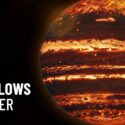Billions of years ago, another planet smashed into Earth. An event of this epicness could have created our Moon. It also could have brought alien life to our planet. What evidence of this planet still exists on Earth today? Could there be life deep inside the Earth’s surface? And could that life be an advanced civilization of humanoid aliens?
4.5 billion years ago, Theia, a protoplanet the size of Mars, struck our young Earth. This collision scattered pieces of both planets into space. And many scientists argue that these pieces eventually coalesced into our Moon. But what happened to the rest of Theia is still a mystery.
The existence of blobs of material inside the Earth’s mantle, known as low-shear velocity provinces, could be evidence that parts of Theia fused with Earth. These chunks are up to 1,000 km (621 mi) in height and several times that in width. They sit below Africa and the Pacific Ocean, straddling the Earth’s core like a pair of headphones.
But other theories, some dating back centuries, suggest a completely different explanation of what exists under the surface. A lush tropical paradise for aliens.
The Earth consists of four layers. The crust, the mantle and the outer and inner core. But there has not been any successful exploration below the crust. So there is much we don’t know about the realities below the surface. This has led to spectacular speculation like the Hollow Earth theory.
According to this, our planet could be a series of nested spheres centered around a central core. In between these shells, atmospheres could exist that are capable of supporting life. In the 17th century, Edmund Halley, the scientist who discovered Halley’s Comet, backed this theory.
Many others have added to it, suggesting a small sun could be hanging in the center of the Earth. And plants, animals and humans could be living there. And not just humans, but a race of superhumans. Immortals who possess sophisticated technology to build hundreds of subterranean cities. But if there were aliens inside the Earth, what would the conditions for life be?
Could the inside of our planet be a luscious paradise? Or a hot, hellish dump? If you were to visit one of the low-shear velocity provinces, you’d have to go 2,900 km (1,800 mi) below the surface. Here, you’d be surrounded by magma, or liquid rock, with temperatures as high as 3,700 °C (6,692 °F). And the weight of the crust and mantle above you would increase the pressure to over 237,000 times the atmospheric pressure.
Whatever life you find here would need to exist in these extreme conditions. And these lifeforms would need to evolve to extract oxygen directly from the magma. Or live without it. They’d need to survive without any sunlight. Radiation would be the primary energy source.
Lucky for them, the radioactive decay of uranium, thorium and potassium in the Earth’s crust and mantle already account for the primary source of heat in the Earth’s interior. There could be all kinds of undiscovered creatures down there. But, until you could withstand the pressure and heat to find out, we’ll never know.
As for the Hollow Earth, it’s nice to imagine a paradise world underneath our feet instead of layers upon layers of hot molten rock. And who knows, maybe there is alien life down there.
Sources
- “New Theory Suggests Large Blobs Of Material In Earth’s Mantle Are Remnants Of Protoplanet Theia”. Bob Yirka. 2021. phys.org.
- “Remains Of Impact That Created The Moon May Lie Deep Within Earth”. Paul Voosen. 2021. science.org.
- “Dynamics And Evolution Of The Deep Mantle Resulting From Thermal, Chemical, Phase And Melting Effects”. Tackley, Paul J. 2012. Earth-Science Reviews 110 (1-4): 1-25. doi:10.1016/j.earscirev.2011.10.001. sciencedirect.com.
- “THE EARTH’s LAYERS – The Inner And Outer Core, The Mantle, The Crust”. 2021. science.jrank.org.
- “The Hollow Earth Is Filled With Giants, Germans, And A Little Sun”. Eric Grundhauser. 2015. atlasobscura.com.



























